Follow Blog via Email
Join 1,558 other subscribersSupport the Peregrine Watch
-
Recent Posts
- Incubation starts… March 23, 2024
- The eggs and I… March 22, 2024
- Scholarship student September 14, 2023
- Scholarship recipients… May 29, 2023
- First flight… May 22, 2023
April 2024 S M T W T F S 1 2 3 4 5 6 7 8 9 10 11 12 13 14 15 16 17 18 19 20 21 22 23 24 25 26 27 28 29 30 Archives
Details
Tags
- accident or injury
- artwork
- Bob Isenberg
- breeding
- brooding
- California
- California Polytechnic State University
- chicks
- Cleve Nash
- courtship
- Doris
- eagles
- education
- eggs
- falcon
- feeding
- gulls
- Heather O'Connor
- hunting
- incubation
- invaders
- juvenile
- mammals
- migration
- Morro Bay
- Morro Bay Winter Bird Festival
- Morro Rock
- other birds
- owl
- peregrines
- photography
- Piedras Blancas Lighthouse
- prey
- scholarship
- Shell Beach
- shorebird
- solstice
- stoop
- summer
- survival
- visitor
- vultures
- weather
- whales
- winter
Join us on Facebook
Tag Archives: accident or injury
Transfer to another place…
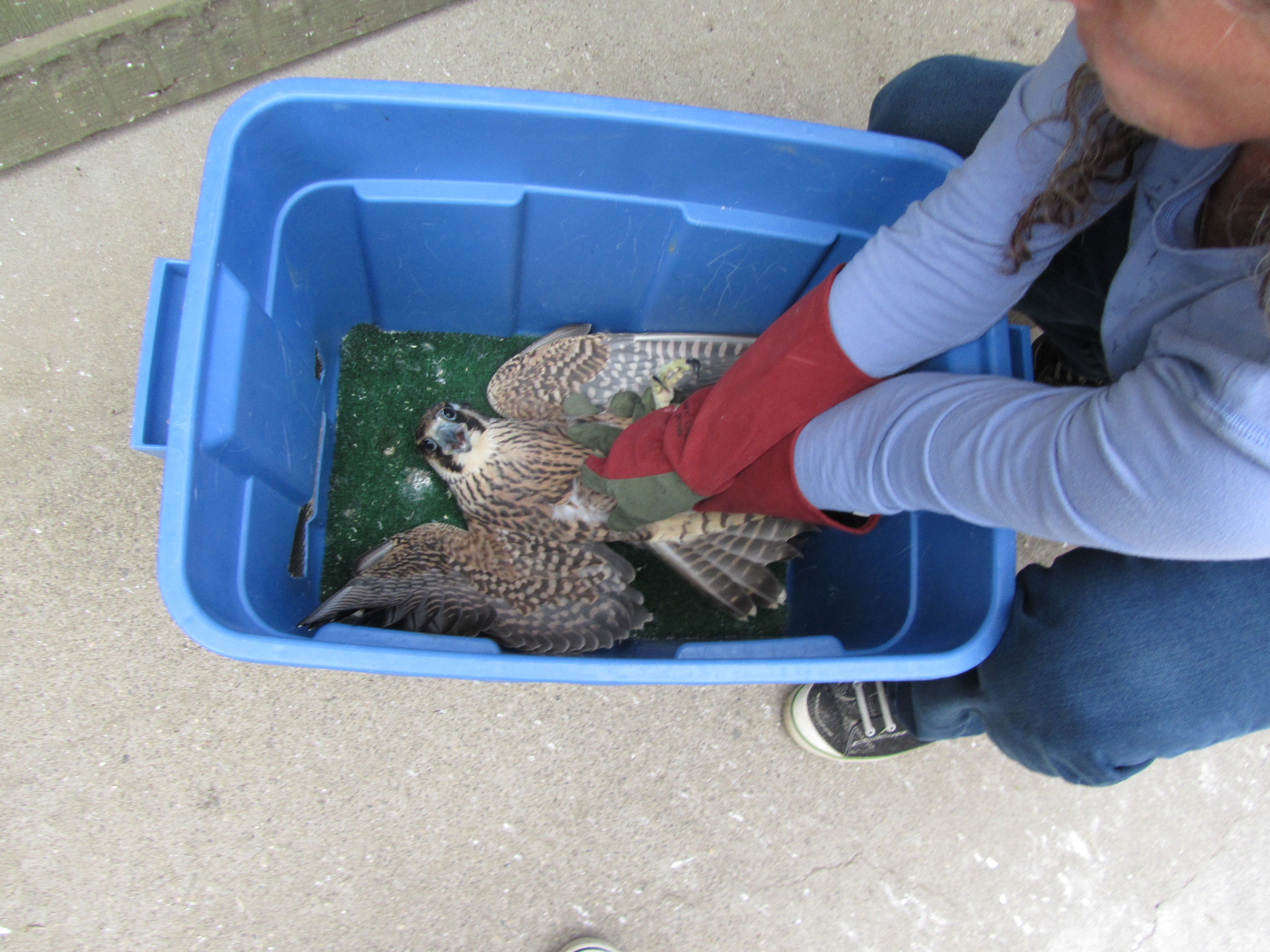
Photo by Jeri Roberts’ assistant
Here is a photo showing the gentle care by Jeri of the juvenile when it was to be moved to another location. Gloves are always used for protection. ~Heather
Posted in falcon, juvenile
Tagged accident or injury, falcon, juvenile, peregrines, survival
Leave a comment
Previous days of recovery…
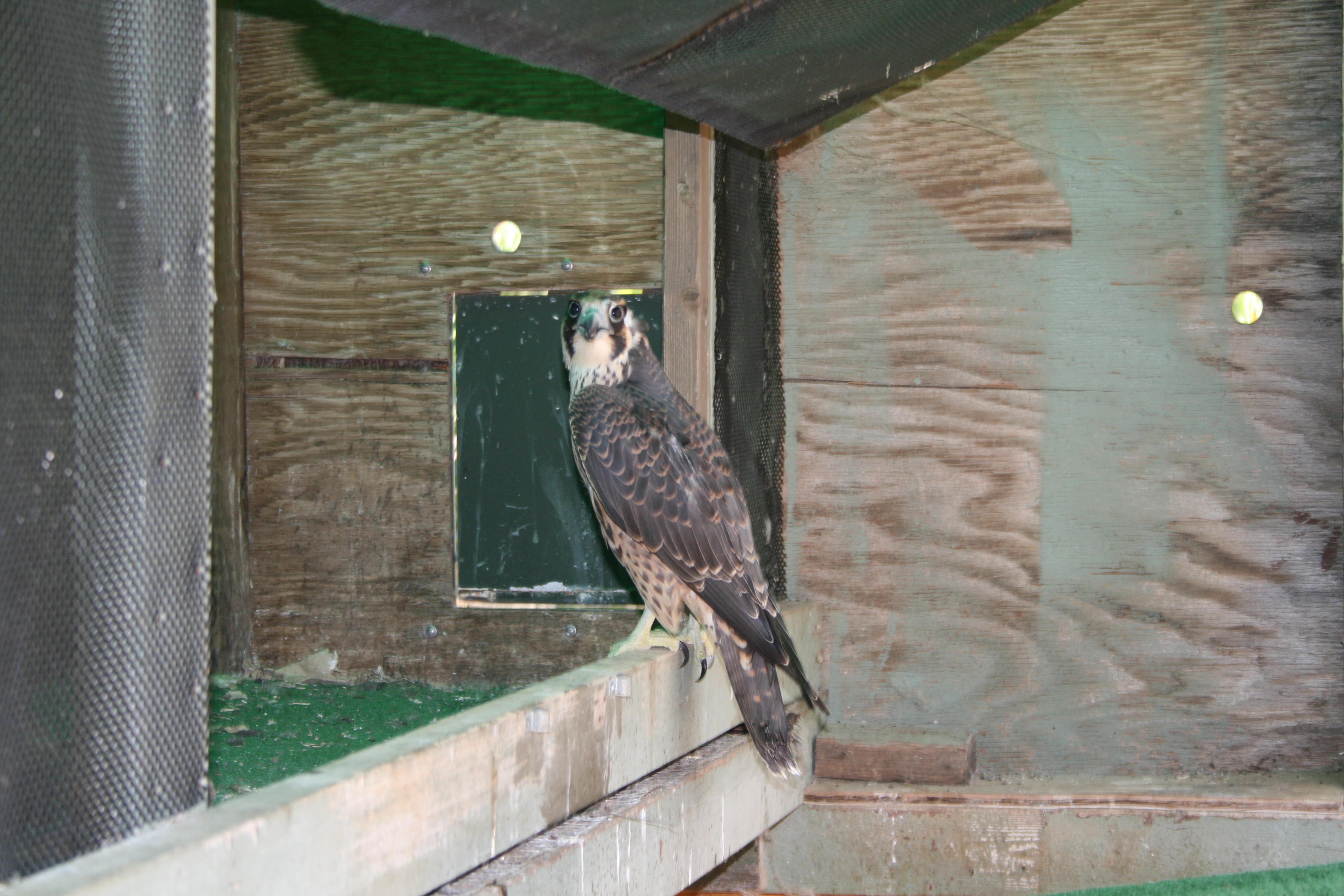
Photos by Jeri Roberts.
I’m adding a few photos to show how Jeri Roberts rehabilitated the peregrine juvenile. It has since been released. ~Heather
Here is another photo. The one where she is perched again shows the feed door (old dog door) where I can deliver food without being seen and she is going into smaller caged area within the larger flight cage that has shade cloth on it that can act like a “cave” that she seemed to like for eating and sleeping sometimes. ~Jeri
Posted in falcon, juvenile
Tagged accident or injury, falcon, feeding, juvenile, peregrines, survival
Leave a comment
Peregrine on the wing…
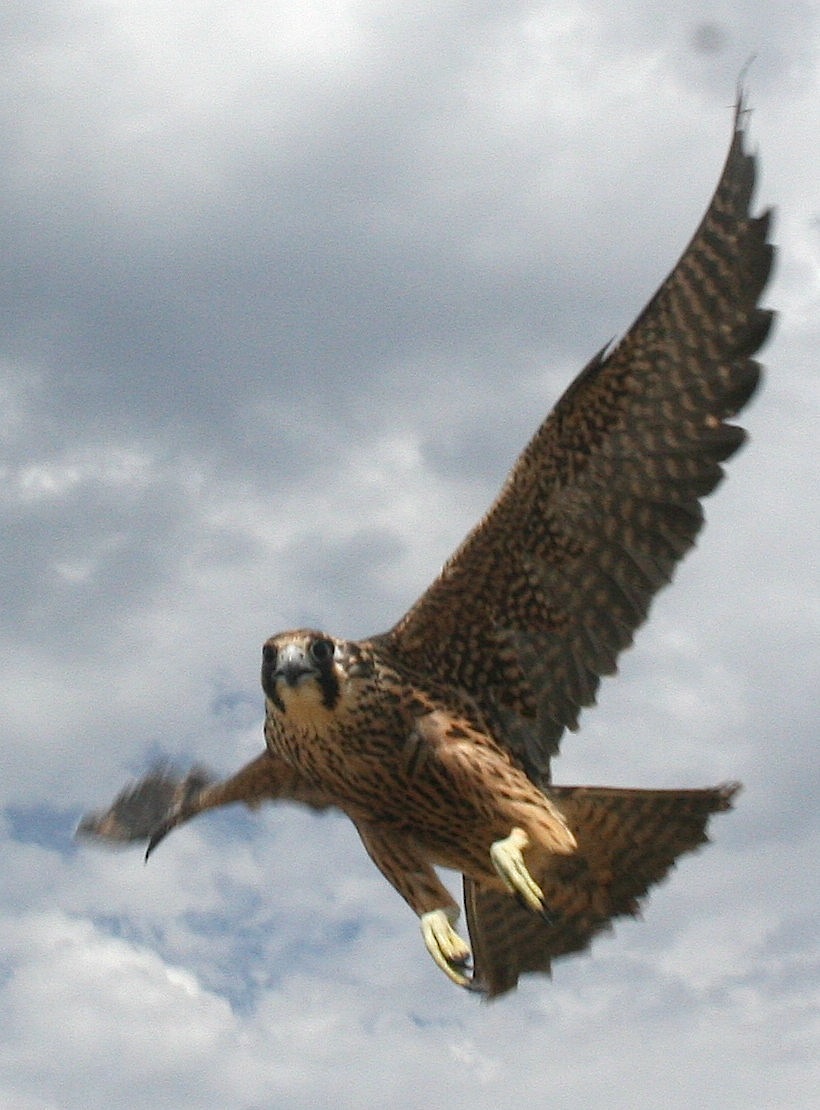
Article and photo by Neil Farrell, Tolosa Press
The article in the following post is what locals read when the Bay News was delivered about town. The people attending the release of the juvenile were Jeri Roberts, skilled rehabilitator of falcons, Brian Roberts, her husband, Bob Isenberg, of Pacific Coast Peregrine Watch, Joyce Cory, birdwatching blogger, Neill Farrell, writer, Jeremiah and Jason of the Harbor Patrrol and me. How fortunate we were to see this exciting event. ~Heather
Posted in falcon, juvenile, Morro Rock
Tagged accident or injury, falcon, juvenile, Morro Rock, peregrines, survival
Leave a comment
Peregrine Saved and Released in Morro Bay…
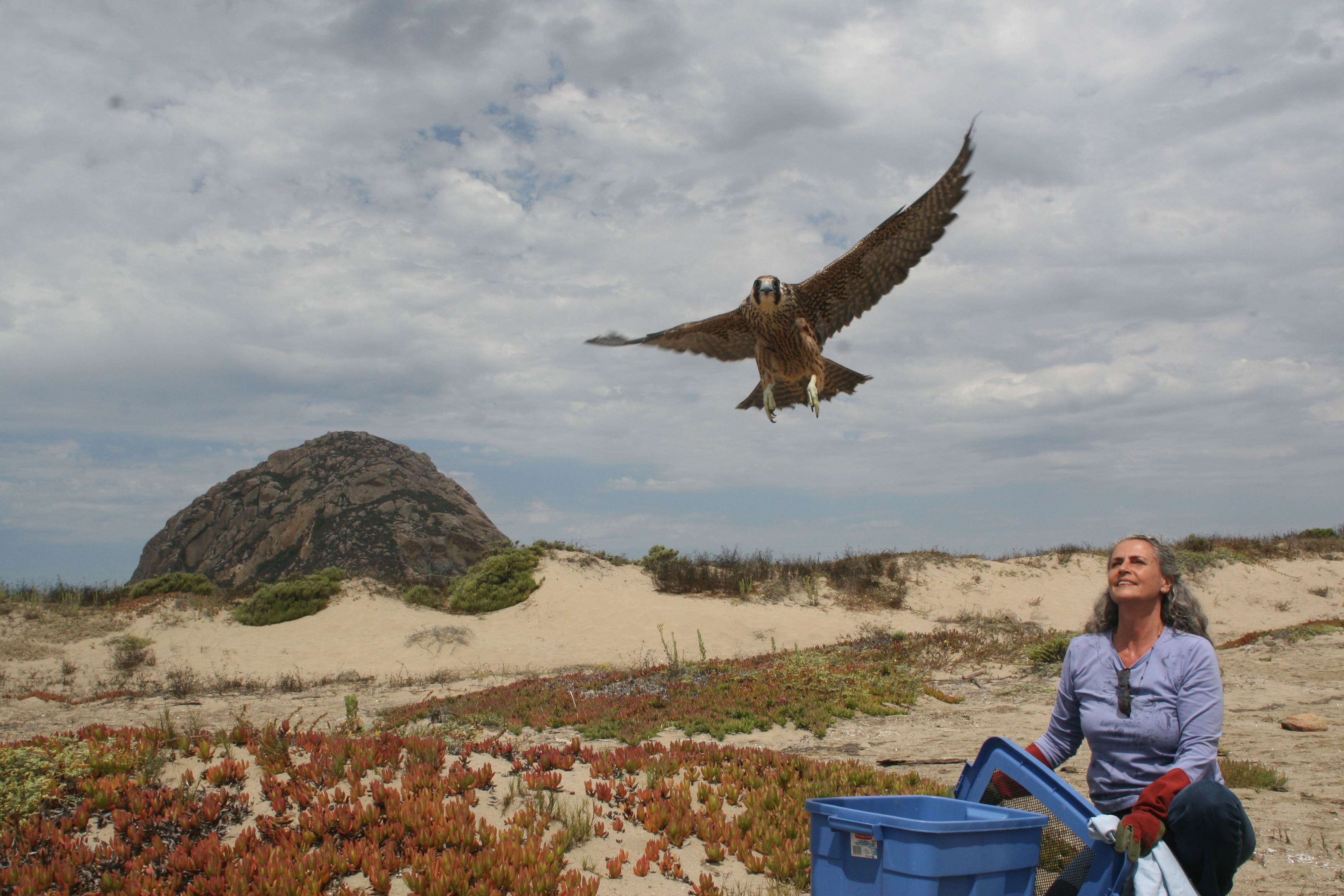
Article and photo by Neil Farrell, Tolosa Press
A juvenile female peregrine falcon is flying once again over Morro Bay Harbor after being rescued, rehabbed and released by Pacific Wildlife Care.
On Saturday, Jeri Roberts of PWC, along with peregrine researchers and friends, hitched a ride with the harbor patrol to the Sandspit at Sandal’s Cove to release the bird back into the wild. There she will possibly rejoin three siblings, part of a brood that hatched and fledged off Morro Rock this season.
The birds were hatched around Easter and flew their nest high up on the southwest side of the Rock on May 22, said Bob Isenberg, of the group Pacific Coast Peregrine Watch (see: pacificcoastperegrinewatch.org) . This bird was found June 26 with a broken wing, wallowing in the water off the Sandspit. She was going to die, but someone gathered the bird up and set in motion its salvation.
PWC took the bird in at its triage center on the power plant property. Roberts said it was examined by a veterinarian, who diagnosed the wing break. “He prescribed the human equivalent of bed rest,” said Roberts.
So the bird was confined in a crate to allow the wing to heal itself. That presents a problem for a critter that can fly 200 mph and is the fastest animal on earth.
“They can ‘de-condition’ rapidly,” explained Roberts, so the plan was to get the bird moving around again as quickly as possible.
“Peregrines are high strung,” she said, “and the triage center has a lot of activity, a lot of noise.” So the bird was transferred to Roberts’ home in Prefumo Canyon. There she has graduated sizes of flight cages, from 6-foot, to 12’, then a 15’ X 10’ and eventually into a 30-foot flight cage.
Though she has another peregrine that along with a Merlin, are used for PWC’s educational programs, they don’t take to company very well.
“You can’t mix two peregrines together,” she said, “they will kill each other.” Playing nice also apparently doesn’t apply for the parent birds either, that’s why they had to release this one on the Sandspit instead of at Morro Rock. Its parents would likely drive her off and Roberts said they would probably have to rescue it again.
In the big flight cage, Roberts said the falcon shared time with an owl also being rehabbed. “They traded off,” she explained. “We had this whole diurnal and nocturnal thing going. I’d take the peregrine out in daylight and the owl would come out at night. We try to get the birds back out into the wild as soon as possible.”
It took about eight weeks to finally release the falcon, which isn’t cheap for an all-volunteer non-profit organization. The falcon ate two 5-week old quail a day, costing more than $5 a day.
“We did right by the bird,” said Roberts. “It’s an expensive undertaking, with x-rays, vet visits, the good diet and feather supplements. She was still growing feathers. It’s turned out very well.”
Once nearing extinction due primarily to habitat loss and poisoning with DDT. The peregrine falcons have made a remarkable comeback since the population hit rock bottom in the 1980s.
Now the four young falcons will have to carve out a niche for themselves but not necessarily here. Falcons are known for traveling far from home to settle down.
For instance, birds that have been tagged locally have shown up in the Channel Islands, Los Angeles and even San Diego.
Isenberg said peregrines have been documented nesting up and down the Central Coast spaced out about every 8-10 miles. Locally there are pairs in Montaña de Oro, Morro Rock, Hollister Peak, Avila Beach, Pismo and on down.
According to Wikipedia, peregrine falcons are the second most widely spread species of bird in the world. About the only place they are not found is Antarctica and above the Arctic Circle.
The birds have adapted to urban living too, nesting on tall buildings and even cathedrals in many large cities. Oddly enough, in the cities, a falcon’s main prey is pigeon, which Wikipedia said is the most widely spread species. On the Sandspit, the falcons have apparently been snacking on snowy plovers.
Posted in falcon, juvenile, Morro Rock
Tagged accident or injury, falcon, juvenile, Morro Rock, peregrines, survival
Leave a comment
Strength and stamina… part 1
http://youtu.be/HGNKeV8kubM
Video by Bob Isenberg
Opening the box to release the rehabilitated juvenile peregrine
Posted in falcon, juvenile, Morro Rock
Tagged accident or injury, falcon, juvenile, Morro Rock, peregrines, survival, whales
Leave a comment
Strength and stamina… part 2
http://youtu.be/PCelkeWIbNo
Video by Bob Isenberg
This is a story that we here in Morro Bay have been waiting for. The young injured falcon. Heather has done all the leg work, phone calls, logistics, news, etc. I think it is hers to tell. Happy trails, Bob
I guess the ball is in my court, so here goes… When I was at the Coastal Discovery Fair for Friends of the Elephant Seals last month, Marcelle, a friend, mentioned that she had heard of and injured falcon, so I went on a search to find out what had happened. Links to the Pacific Wildlife Care Center connected me to Jeri Roberts who was rehabilitating the peregrine. Its wing had been broken most likely in a crash with prey due to a miscalculated kill or jousting or a collision with a power lines or guy wire. Lots of possibilities, but the broken ulna needed to be wrapped to the more stable and stronger radius bone. She was mending.
After weeks of careful and conscientious attention, this young falcon who had been injured June 26 was now ready to be released. Jeri had increased the size of her cage gradually from a small confining crate to a 30 foot flight cage. We wanted to release her on the sand-spit where the she had been found. We needed a boat, a way to transport her. We spoke with Kevin at SubSeas Whale Watching Tours who suggested that we might call on the Harbor Patrol. Putting her in the same location where she had been found would be the best.
Leaving home in Prefumo Canyon, Jeri had said that the falcon had started quacking when she smelled the sea air near Los Osos and more loudly quacked as the car in which she rode neared the Morro BayCoast Guard Station. Off we went on the Harbor Patrol boat skippered by Jeremiah to the sand-spit. Stepping onto the sand-spit, we climbed the sliding sand up to the perfect place to release her, a wide open area. Jeri opened the blue box lid slowly and off our youngster went, so gracefully on wing, flapping and gliding and covering distance so easily. She was a very happy bird! She made a few loops to orient herself and started to gain height and go further. The falconer’s term is “she was ringing up.” We were all amazed at her strength and stamina. Jeri was so pleased to see the conditioning of our very athletic bird paid off. Often a bird would fly and then quickly rest. This one had the endurance needed to go far and wide. Off and over Morro Bay and the Estuary towards the Morro Bay Museum of Natural History. She then perched in a very tall eucalyptus. She had recovered.
After a small jaunt to the mouth of the inlet to see thousands of Sooty Shearwaters and a few humpback whales spouting, we all headed back to the dock having seen the very satisfying recovery of a peregrine falcon. ~Heather
Posted in falcon, juvenile
Tagged accident or injury, falcon, juvenile, peregrines, survival, whales
Leave a comment
Above the rest…
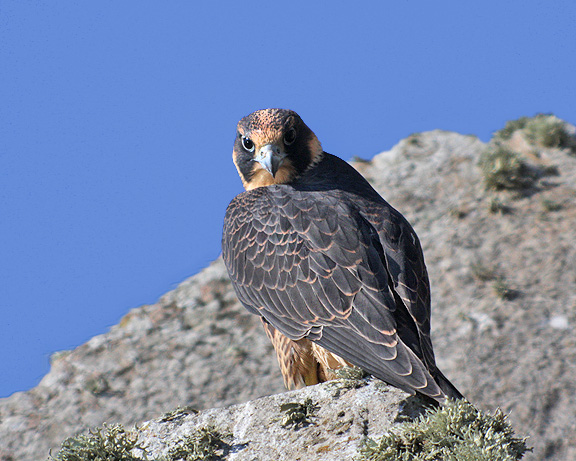
Photo by Cleve Nash
This is the third in a series of tales about the “famous and not-so-famous birds of Morro Rock.
Before I get into the story of our third famous bird, I would like to give our readers an update on the injured falcon chick found June 26, 2012. The young bird is doing well. She has been moved to a larger 30 foot flight cage where she is being conditioned to fly. With full time care by Jeri Roberts, she will be released in the next week or so. I hope to have a video of this.
Every few years, we have a clutch of young falcons with one bird in it that shines head and heels above the others. This bird was hatched on the north side of the rock in a cast of three falcons. He was a small male, distinctively colored with a pale bleached blond hairdo. Some one called him the “Surfer” and the name stuck. He was very gregarious and much of a loner. He didn’t seem to indulge in nestling games. You might say he didn’t play well with others. He was farther ahead of the others in every respect, very agile and coordinated. As they got older and ready to fledge, the other two would flap to strengthen their muscles, but the “Surfer” instead flew straight off the ledge and across the bay to the big power plant and landed on the roof. We were all astonished and amazed. They don’t do this. They fly 50 feet and crash in a bush. For the next couple of days, they might go 200 yards and get stuck on a steep slope for two hours. But not the “Surfer.” On his third day of flying, he tried to grab a swallow over the north parking lot. The other two young falcons could only watch and wish.
By fall when it is time for the adults to chase the young off, the “Surfer” was already gone. I missed him. He was special.
Happy trails, Bob
Posted in chicks, falcon, juvenile, Morro Rock
Tagged accident or injury, chicks, falcon, juvenile, Morro Rock, peregrines, survival
Leave a comment
I just had to find out…
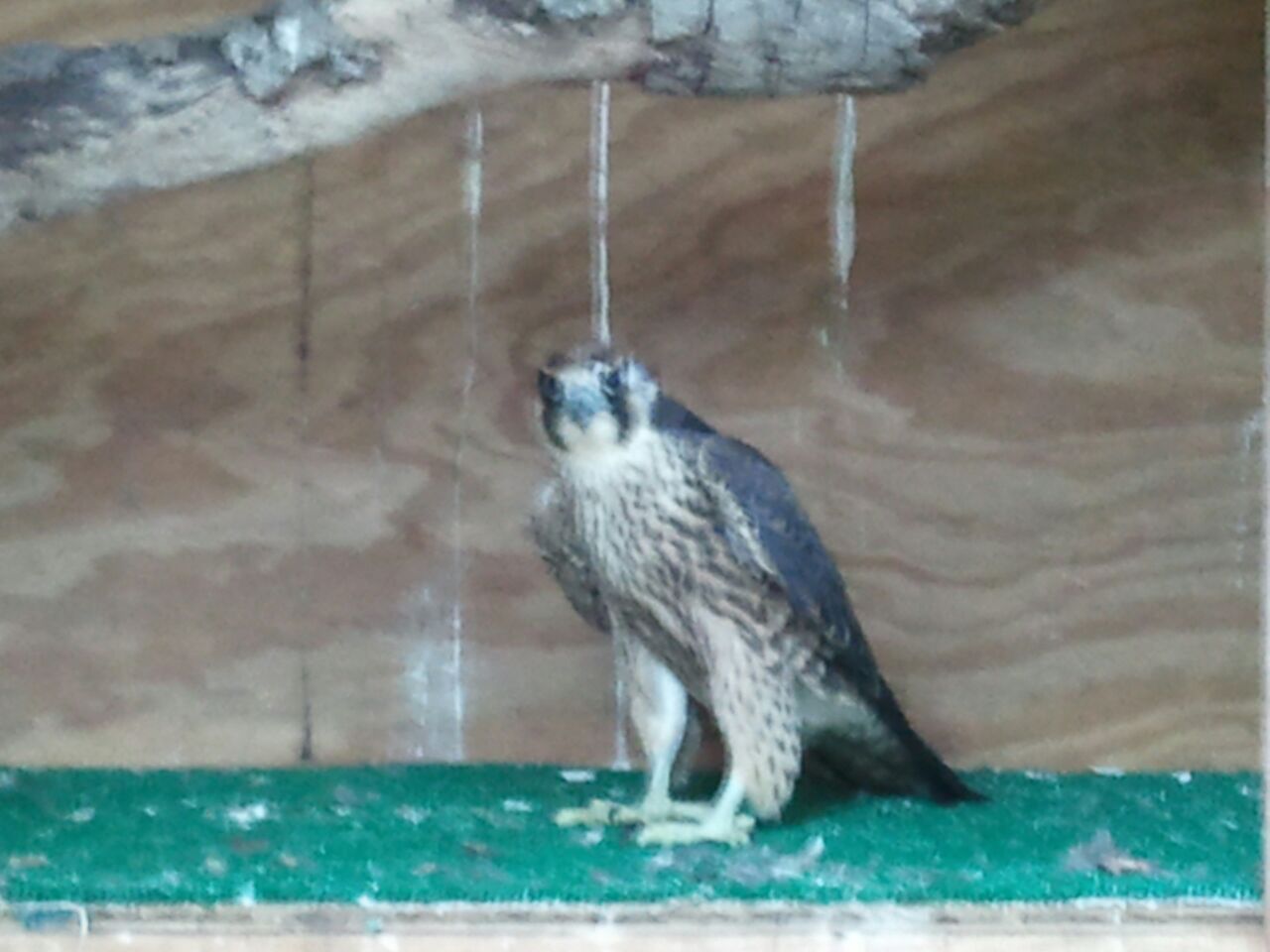
We are trying to keep you abreast of the peregrines activities at the rock, but it’s been rather quiet since the juveniles have fledged and flown over to the sand-spit to learn survival skills and hunt. In addition to the comings and goings of the magnificent and regal peregrines, the vultures have been coming in twice a day to visit the old nest site. No black downy chicks have shown up. It is just speculation that they might be there. Bob said they could hatch late in the season because there would be higher attrition rate among other young juvenile birds of all breeds. The vultures would be the clean up crew. We’ll keep watching.
Last Saturday I went up to work at the Coastal Discovery Fair for Friends of the Elephant Seals. At the fair, I met Marcelle who mentioned that a peregrine had been brought into Pacific Wildlife Care on June 26. It had been injured, so I just had to find out what the details were to pass them on to you. Bob mentioned that peregrines who have broken wings are usually from miscalculated kills, hunting accidents, jousting, sparring and collisions with power lines and guy wires.
A few days later after a long conversation with Jeri Roberts, I learned that it was a juvenile female falcon found by a boater on the bayside of the sand-spit. It may have been one of our four chicks from the south side of the rock not “Solo” from the north side, who Bob has seen frequently over the past few days. This injured bird had fallen into the water with a broken wing. More carefully examined, it had a left eye abrasion. Pacific Wildlife Care decided to splint the wing because it was the ulna that was broken and could be strapped to the larger bone, the radius. No pinning of the ulna was necessary. Bones in these young birds knit quickly. The peregrine was confined to a small carrier, something an extremely athletic bird doesn’t like at all, but it had to be done so the broken bone would knit. She had her vision limited with a falconer’s hood. So as soon as possible, she’ll be moved into a small flight cage. They then gradually move the bird up to a larger cage when they think it is safe to do so. It’s a delicate balancing act confining the peregrine to have the wing heal and keeping it from becoming depressed from lack of space. Consider an Olympic athlete having a broken bone and being restricted severely until it heals!
She weighed 930 grams on arrival and now weighs 1009 grams. We think she is doing quite well. Average weight for females: 825-1094grams and for males: 550-647grams
At the end of our conversation, I asked her if I would be able to take a photo. “No,” said she. Since this type bird is very territorial and easily upset, it wouldn’t be a good idea. Jeri said that she cautiously feeds this young female so as to not upset her, but she did take a cell phone photo very cautiously for you to see. Can’t see the wing wrap though. We’ll keep in touch, plan to see and photograph her when possible and, of course, see her released! ~Heather
Posted in falcon, juvenile
Tagged accident or injury, falcon, juvenile, peregrines, survival, vultures
Leave a comment

